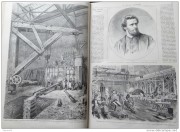Virtual reality
Halleluyah! You know how meticulous I am in reproducing the time and place of my novel: Paris, 1870-71. I’m constructing it with the same mind-set as Daguerre when he designed the dioramas that made him rich, before his factory burned down and he decided to invent photography. Those dioramas were sound-and-light shows that so confused spectators that they weren’t sure if they were really in a theater or had been transported to the distant (and sometimes wholly imaginary) scene displayed. (Cf. Walter Benjamin, “Paris—Capital of the 19th Century” for a discussion of their importance in changing ways of seeing.)
I don’t have a factory with huge canvases, cranks and gears, shutters and lanterns, so I hope to create the diorama, which is also a (simulated) time machine, in your brain with words, and to make my virtual reality as convincing as possible, I want to bring onto the scene real personalities and events — just as Daguerre used real tree branches and other props in the foreground of his huge canvases.
All this to explain to you why I just experienced a little thrill in my effort to create this virtual reality, a novel of dramatic changes (lights, sounds, action) in what was then considered the greatest city in the world, Paris, leading to the enormous climax of the Commune of 1870. And I have just discovered that one important detail that I had imagined turns out to be absolutely true—a “real” reality.
I had invented a bronze worker, and assigned him a typical age and residence for the men who really defended the barricades in “the week of blood”: born 1834 in Belleville, the “reddest” working-class quartier in Paris. In the pre-war years, I supposed that his foundry was producing fine luxury goods (bronze statuary, clocks, vases, etc.) and bronze and copper household goods such as tubs and pans, but when war with Prussia was declared in 1870 and Paris was bombarded, the foundry would be one of those that switched production to bronze cannons.
All of this seemed possible, even probable, but I needed to be sure. Now, thanks to the documents on Gallica from the Bibliothèque Nationale de France, I have found the very foundry where my man works, Broquin & Lainé, and it is situated only a 7 minute walk from Belleville (I checked on Google maps). It was already famous for just the kind of production I mentioned (it exhibited and won prizes in the world’s fair, or “Exposition universelle”, in 1867). And in 1870, it set to casting cannons for the defense of Paris against the Prussians. (Those cannons would again enter the story at the time of the Commune).
Then, once I had the name of the foundry, I discovered images of its new line of production, the cannons. Here are two from Le Monde Illustré, No 721 (4 February 1871), which you can find here and here (in Gallica, Bibliothèque Nationale de France) . The man pictured is Henri Regnault, an artist known from his patriotic sculptures in bronze.
